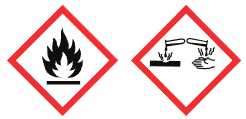TRIMETHYLGALLIUM CAS#: 1445-79-0; ChemWhat Code: 109924
Identification
Physical Data
No data available
| Density, g·cm-3 | Measurement Temperature, °C |
| 1.453 | -130.16 |
| 1.448 | -153.16 |
| 1.453 | -140.16 |
| Description (Association (MCS)) | Partner (Association (MCS)) |
| Adsorption | silica |
| Adsorption | InSb(100) |
| Adsorption | GaN(0001) |
Spectra
| Description (NMR Spectroscopy) | Nucleus (NMR Spectroscopy) | Solvents (NMR Spectroscopy) |
| Chemical shifts | 1H | benzene-d6 |
| Chemical shifts | 13C | benzene-d6 |
| Chemical shifts | 1H | (2)H8-toluene |
| Chemical shifts | 13C | (2)H8-toluene |
| Description (IR Spectroscopy) | Solvent (IR Spectroscopy) | Temperature (IR Spectroscopy), °C |
| Spectrum | neat (no solvent, gas phase) | 300.84 |
| Bands | neat (no solvent, gas phase) | 300.84 |
| Bands | further solvent(s) | -153.16 – -133.16 |
| Bands | neat (no solvent) | 9.84 |
| Description (UV/VIS Spectroscopy) | Solvent (UV/VIS Spectroscopy) | Comment (UV/VIS Spectroscopy) |
| Spectrum | gas | 190 nm – 310 nm |
| Spectrum, Band assignment | neat (no solvent) | 106 nm – 270 nm |
| Spectrum | gaseous matrix | 190 nm – 390 nm |
Route of Synthesis (ROS)
Route of Synthesis (ROS) of TRIMETHYLGALLIUM CAS 1445-79-0
| Conditions | Yield |
| With magnesium In neat (no solvent) byproducts: MgI2; inert atm.; heating (autoclave, 120-160°C, 12 h); distn.; | 65% |
Safety and Hazards
| Pictogram(s) |  |
| Signal | Danger |
| GHS Hazard Statements | H225 (15.64%): Highly Flammable liquid and vapor [Danger Flammable liquids] H250 (100%): Catches fire spontaneously if exposed to air [Danger Pyrophoric liquids] H260 (84.36%): In contact with water releases flammable gases which may ignite spontaneously [Danger Substances and mixtures which in contact with water, emit flammable gases] H261 (15.64%): In contact with water releases flammable gas [Danger Substances and mixtures which in contact with water, emit flammable gases] H314 (100%): Causes severe skin burns and eye damage [Danger Skin corrosion/irritation] H318 (60.91%): Causes serious eye damage [Danger Serious eye damage/eye irritation] |
| Precautionary Statement Codes | P210, P222, P223, P231, P231+P232, P233, P240, P241, P242, P243, P260, P264, P264+P265, P280, P301+P330+P331, P302+P335+P334, P302+P361+P354, P303+P361+P353, P304+P340, P305+P354+P338, P316, P317, P321, P363, P370+P378, P402+P404, P403+P235, P405, and P501 (The corresponding statement to each P-code can be found at the GHS Classification page.) |
Other Data
| Shelf Life | 1 year |
| Druglikeness | |
| Lipinski rules component | |
| Molecular Weight | 114.827 |
| logP | 1.584 |
| HBA | 0 |
| HBD | 0 |
| Matching Lipinski Rules | 4 |
| Veber rules component | |
| Polar Surface Area (PSA) | 0 |
| Rotatable Bond (RotB) | 0 |
| Matching Veber Rules | 2 |
| Toxicity/Safety Pharmacology |
| Quantitative Results |
| Use Pattern |
| TRIMETHYLGALLIUM CAS#: 1445-79-0 serves as a key precursor in thin film deposition technologies, including CVD and ALD. It is used to deposit high-quality gallium compound films in the semiconductor industry and other fields. And Trimethylgallium plays a critical role in the fabrication of optoelectronic devices, including solar cells and other optoelectronic devices. Trimethylgallium is also utilized in metalorganic chemistry as an organometallic precursor, participating in some organic synthesis reactions. |
Buy Reagent | |
| No reagent supplier? | Send quick inquiry to ChemWhat |
| Want to be listed here as a reagent supplier? (Paid service) | Click here to contact ChemWhat |
Approved Manufacturers | |
| Want to be listed as an approved manufacturer (Requires approvement)? | Please download and fill out this form and send back to approved-manufacturers@chemwhat.com |
Contact Us for Other Help | |
| Contact us for other information or services | Click here to contact ChemWhat |

